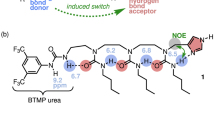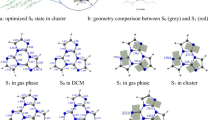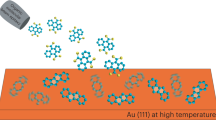Abstract
Three imidazole-containing conjugated oligomers (O1, O2, and O3) were synthesized by a Suzuki–Miyaura cross-coupling polymerization in combination with a post-polymerization reaction to clarify the structure–property–conformation relationship and ultimately develop a method for accessing helical secondary structures in the future. HR-ESI-MS analysis of the model reaction mixture revealed that debromination is responsible for the low molecular weight of these oligomers. The absorption and emission peak maxima gradually redshifted moving from O2 to O1 to O3, which can be rationalized by the number of intramolecular hydrogen bonds (IHBs). O2, with no IHBs, and O3, which forms multiple robust IHBs, were insensitive to the nature of the solvent, while O1, with weak IHBs, exhibited solvent-dependent absorption spectra. O3 was susceptible to both acid and base treatment, namely, the addition of HCl caused a blueshift in the absorption spectra, and the addition of NaOH resulted in a complex shift in the peak depending on the degree of deprotonation. A conformational study based on DFT calculations indicated that the formation of the IHB network potentially endows O3 with a helical conformation.
Similar content being viewed by others
Log in or create a free account to read this content
Gain free access to this article, as well as selected content from this journal and more on nature.com
or
References
Rickhaus M, Mayor M, Juríček M. Strain-induced helical chirality in polyaromatic system. Chem Soc Rev. 2016;45:1542–56.
Blake AJ, Cooke PA, Doyle KJ, Gair S, Simpkins NS. Poly-orthophenylenes: Synthesis by Suzuki coupling and solid state helical structures. Tetrahedron Lett. 1998;39:9093–6.
He J, Crase JL, Wadumethrige SH, Thakur K, Dai L, Zou S, et al. ortho-Phenylenes: Unusual conjugated oligomers with a surprisingly long effective conjugation length. J Am Chem Soc. 2010;132:13848–57.
Mathew SM, Hartley CS. Parent o-phenylene oligomers: Synthesis, conformational behavior, and characterization. Macromolecules. 2011;44:8425–32.
Hartley CS. Excited-state behavior of ortho-phenylenes. J Org Chem. 2011;76:9188–91.
Mathew SM, Engle JT, Ziegler CJ, Hartley CS. The role of arene-arene interactions in the folding of ortho-phenylenes. J Am Chem Soc. 2013;135:6714–22.
Ohta E, Sato H, Ando S, Kosaka A, Fukushima T, Hashizume D, et al. Redox-responsive molecular helices with highly condensed π-clouds. Nat Chem. 2011;3:68–73.
Ando S, Ohta E, Kosaka A, Hashizume D, Koshino H, Fukushima T, et al. Remarkable effects of terminal groups and solvents on helical folding of o-phenylene oligomers. J Am Chem Soc. 2012;134:11084–7.
Lotter D, Neuburger M, Rickhaus M, Häussinger D, Sparr C. Stereoselective arene-folding aldol condensation: Synthesis of configurationally stable oligo-1,2-naphthylenes. Angew Chem Int Ed. 2016;55:2920–3.
Motomura T, Nakamura H, Suginome M, Murakami M, Ito Y. Synthesis and structural analysis of oligo(naphthylene-2,3-diyl)s. Bull Chem Soc Jpn. 2005;78:142–6.
Ito Y, Ihara E, Murakami M. Enantioselective polymerization of 1,2-diisocyanoarenes—Synthesis of optically active, helical poly(quinoxaline-2,3-diyl)s. Angew Chem Int Ed. 1992;31:1509–10.
Ito Y, Ohara T, Shima R, Suginome M. Highly screw-sense selective polymerization of 1,2-diisocyano-3,6-di-p-tolylbenzene initiated by optically active binaphthylpalladium(II) complexes. J Am Chem Soc. 1996;118:9188–9.
Ito Y, Miyake T, Hatano S, Shima R, Ohara T, Suginome M. Asymmetric synthesis of helical poly(quinoxaline-2,3-diyl)s by palladium-mediated polymerization of 1,2-diisocyanobenzenes: Effective control of the screw-sense by a binaphthyl group at the chain-end. J Am Chem Soc. 1998;120:11880–93.
Ito Y, Miyake T, Ohara T, Suginome M. Asymmetric synthesis of helically stable poly(quinoxaline-2,3-diyl)s having hydrophilic and/or hydrophobic side chains. Macromolecules. 1998;31:1697–9.
Blatchly RA, Tew GN. Theoretical study of helix formation in substituted phenylene Ethynylene oligomers. J Org Chem. 2003;68:8780–5.
Nelson JC, Saven JG, Moore JS, Wolynes PG. Solvophobically driven folding of nonbiological oligomers. Science. 1997;277:1793–6.
Delnoye DAP, Sijbesma RP, Vekemans JAJM, Meijer EW. π-Conjugated oligomers and polymers with a self-assembled ladder-like structures. J Am Chem Soc. 1996;118:8717–8.
Monkman AP, Pålsson L-O, Higgins RWT, Wang C, Bryce MR, Batsanov AS, et al. Protonation and subsequent intramolecular hydrogen bonding as a method to control chain structure and tune luminescence in heteroaromatic conjugated polymers. J Am Chem Soc. 2002;124:6049–55.
Vetrichelvan M, Valiyaveettil S. Intramolecular-hydrogen-bond-assisted planarization of asymmetrically functionalized alternating phenylene-pyridinylene copolymers. Chem – Eur J. 2005;11:5889–98.
Zhu C, Mu AU, Wang C, Ji X, Fang L. Synthesis and solution processing of a rigid polymer enabled by active manipulation of intramolecular hydrogen bonds. ACS Macro Lett. 2018;7:801–6.
Cary JM, Moore JS. Hydrogen bond-stabilized helix formation of a m-phenylene oligomer. Org Lett. 2002;4:4663–6.
Yang X, Yuan L, Yamato K, Brown AL, Feng W, Furukawa M, et al. Backbone-rigidified oligo(m-phenylene ethynylenes). J Am Chem Soc. 2004;126:3148–62.
Ando S, Fukushima T, Yamaguchi T. Discrete self-assembly and functionality of guest molecules in an organic framework. Chem Mater. 2016;28:5847–54.
Evans CM, Sanoja GE, Popere BC, Segalman RA. Anhydrous proton transport in polymerized ionic liquid block copolymers: Role of block length, ionic content, and confinement. Macromolecules. 2016;49:395–404.
Chakraborty C, Rana U, Pandey RK, Moriyama S, Higuchi M. One-dimensional anhydrous proton conducting channel formation at high temperature in a Pt(II)-based metallo-supramolecular polymer and imidazole system. ACS Appl Mater Interfaces. 2017;9:13406–14.
Jankowska A, Zalewska A, Skalska A, Ostrowski A, Kowalak S. Proton conductivity of imidazole entrapped in microporous molecular sieves. Chem Commun. 2017;53:2475–8.
Nagarkar SS, Horike S, Itakura T, Ouay BL, Demessence A, Tsujimoto M, et al. Enhanced and optically switchable proton conductivity in a melting coordination polymer crystal. Angew Chem Int Ed. 2017;56:4976–81.
Kawada A, McGhie A, Labes AR, M. M. Protonic conductivity in imidazole single crystal. J Chem Phys. 1970;52:3121–5.
Agmon N. The Grotthuss mechanism. Chem Phys Lett. 1995;244:456–62.
Takagi K, Sugihara K, Ohta J, Yuki Y, Matsuoka S, Suzuki M. Conjugated oligomers containing imidazole in main chain with intramolecular hydrogen bonding. Polym J. 2008;40:614–21.
Takagi K, Ito K, Yamada Y, Nakashima T, Fukuda R, Ehara M, et al. Synthesis and optical properties of fused π-conjugated imidazole compounds. Chem Lett. 2017;46:1372–5.
Takagi K, Ito K, Yamada Y, Nakashima T, Fukuda R, Ehara M, et al. Synthesis and optical properties of excited-state intramolecular proton transfer active pi-conjugated benzimidazole compounds: Influence of structural rigidification by ring fusion. J Org Chem. 2017;82:12173–80.
Takagi K, Yamada Y, Fukuda R, Ehara M, Takeuchi D. ESIPT emission behavior of methoxy-substituted 2-hydroxyphenylbenzimidazole isomers. New J Chem. 2018;42:5923–8.
Ugur I, Marion A, Parant S, Jensen JH, Monard G. Rationalization of the pKa values of alcohols and thiols using atomic charge descriptors and its application to the prediction of amino acid pKa's. J Chem Inf Model. 2014;54:2200–13.
Acknowledgements
A portion of this work was financially supported by the Tokuyama Science Foundation.
Author information
Authors and Affiliations
Corresponding author
Ethics declarations
Conflict of interest
The authors declare that they have no conflict of interest.
Electronic supplementary material
Rights and permissions
About this article
Cite this article
Takagi, K., Ohta, Jy., Sugihara, K. et al. Potentially helical imidazole-containing conjugated oligomers: synthesis, optical properties, and conformation. Polym J 51, 389–395 (2019). https://doi.org/10.1038/s41428-018-0146-3
Received:
Revised:
Accepted:
Published:
Issue date:
DOI: https://doi.org/10.1038/s41428-018-0146-3



